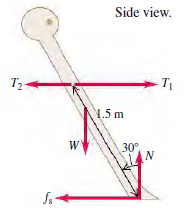Question: If he leans slightly farther back (increasing the angle between his body and the vertical) but remains stationary in this new position, which of the
(a) The difference between T1 and T2 will increase, balancing the increased torque about his feet that his weight produces when he leans farther back;
(b) The difference between T1 and T2 will decrease, balancing the increased torque about his feet that his weight produces when he leans farther back;
(c) Neither T1 nor T2 will change, because no other forces are changing;
(d) Both T1 and T2 will change, but the difference between them will remain the same.
In a study of the biomechanics of the tug-of-war, a 2.0-m-tall, 80.0-kg competitor in the middle of the line is considered to be a rigid body leaning back at an angle of 30.0o to the vertical. The competitor is pulling on a rope that is held horizontal a distance of 1.5 m from his feet (as measured along the line of the body). At the moment shown in the figure, the man is stationary and the tension in the rope in front of him is T1 = 1160 N. Since there is friction between the rope and his hands, the tension in the rope behind him, T2, is not equal to T1. His center of mass is halfway between his feet and the top of his head. The coefficient of static friction between his feet and the ground is 0.65.

Side view. T2 1.5m 30
Step by Step Solution
3.41 Rating (185 Votes )
There are 3 Steps involved in it
IDENTIFY and SET UP The forces and torques on the co... View full answer

Get step-by-step solutions from verified subject matter experts


